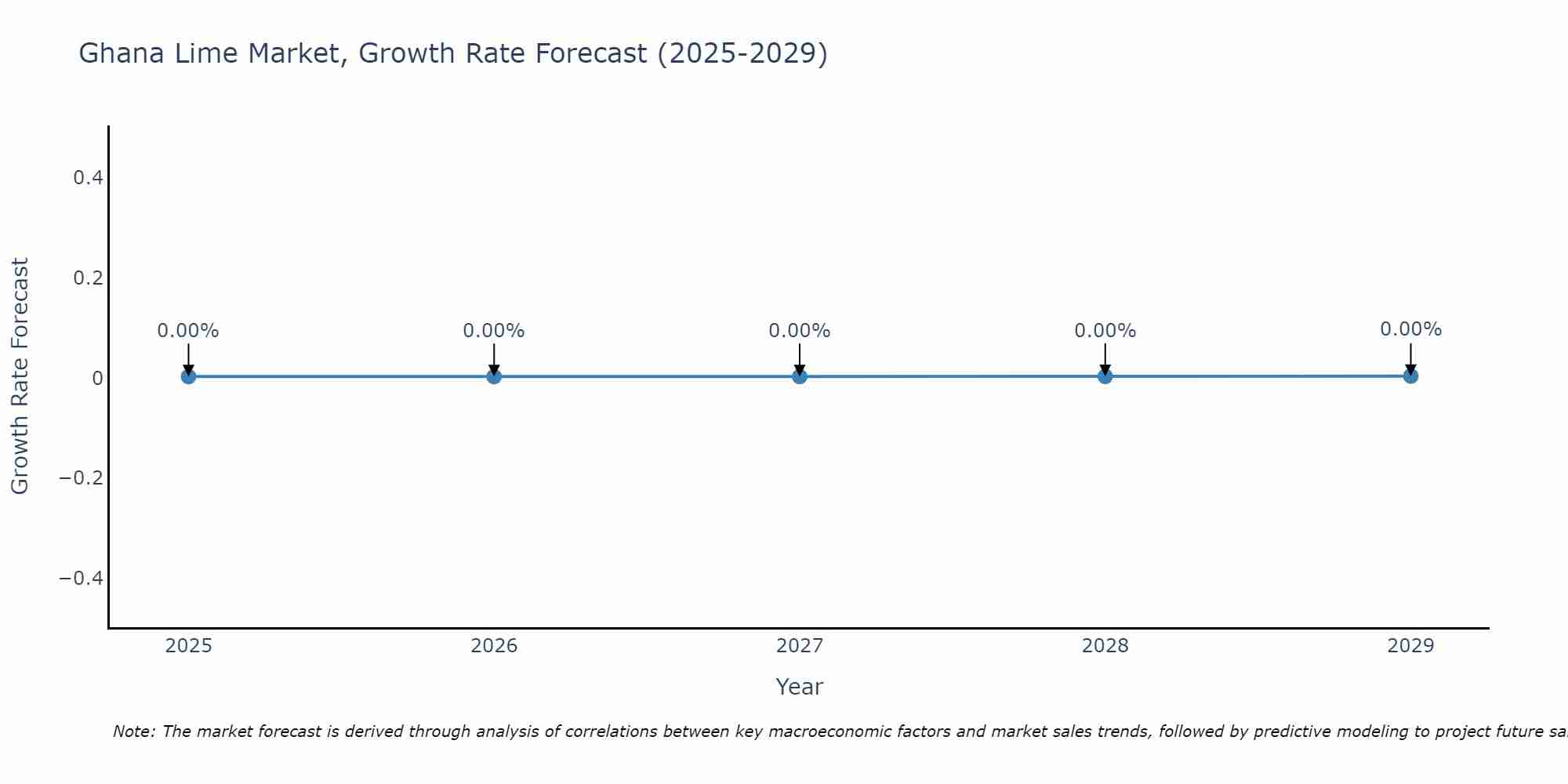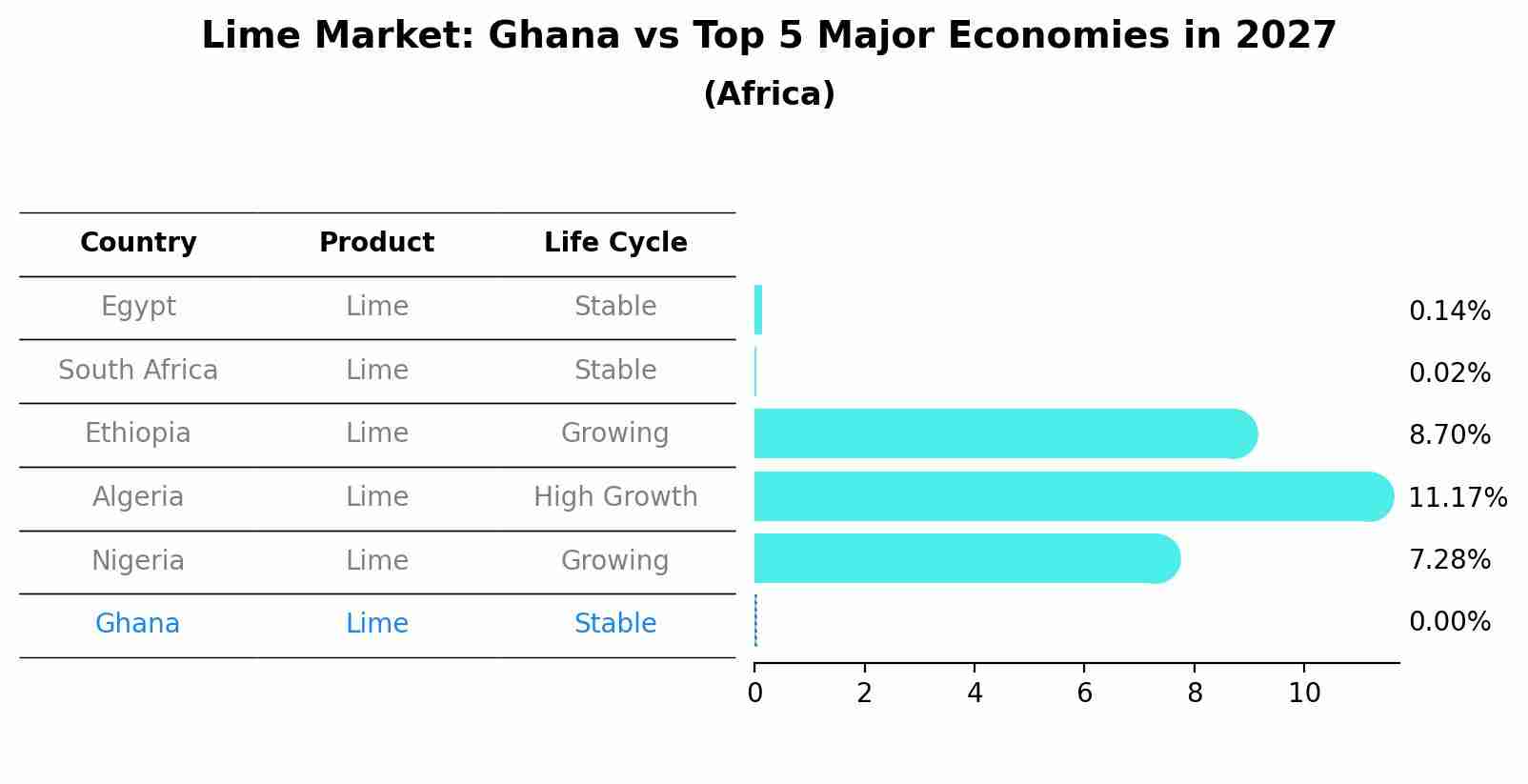Ghana Lime Market (2025-2031) | Forecast, Analysis, Size, Value, Companies, Revenue, Trends, Growth, Industry, Share & Outlook
| Product Code: ETC008356 | Publication Date: Oct 2020 | Updated Date: Jun 2025 | Product Type: Report | |
| Publisher: 6Wresearch | Author: Ravi Bhandari | No. of Pages: 70 | No. of Figures: 35 | No. of Tables: 5 |
Ghana Lime Market Size Growth Rate
The Ghana Lime Market is poised for steady growth rate improvements from 2025 to 2029. The growth rate starts at 0.00% in 2025 and reaches 0.00% by 2029.

Lime Market: Ghana vs Top 5 Major Economies in 2027 (Africa)
The Lime market in Ghana is projected to grow at a stable growth rate of 0.00% by 2027, within the Africa region led by Egypt, along with other countries like South Africa, Ethiopia, Algeria and Nigeria, collectively shaping a dynamic and evolving market environment driven by innovation and increasing adoption of emerging technologies.

Ghana Lime Market Overview
The Ghana lime market is experiencing steady growth driven by increasing demand from various end-use industries such as food and beverages, construction, and agriculture. The rising consumer preference for natural and organic products is also contributing to the market growth. Additionally, the growing awareness about the health benefits of lime, such as its high vitamin C content and antioxidant properties, is further fueling the market expansion. Local lime producers in Ghana are focusing on enhancing their production capabilities and quality standards to meet the rising demand both domestically and for export markets. However, challenges such as fluctuating prices of raw materials and competition from imported lime products are factors that may impact the market growth in the coming years.
Ghana Lime Market Trends
The Ghana lime market is experiencing a growing demand for fresh lime products due to increasing consumer preference for healthy and natural ingredients in food and beverages. There is a rising awareness about the health benefits of lime, such as its high vitamin C content and antioxidant properties. This has led to a surge in lime-based products in the market, including lime-infused water, cocktails, and culinary dishes. Additionally, the beauty and personal care industry in Ghana is also incorporating lime extracts in skincare products due to its rejuvenating and brightening properties. Producers and retailers in the lime market are focusing on promoting the versatility and versatility of lime as a key ingredient, driving the market growth further.
Ghana Lime Market Challenges
In the Ghana Lime Market, some of the key challenges faced include inconsistent supply due to seasonal variations in production, inadequate infrastructure for post-harvest handling leading to high wastage rates, limited access to modern farming techniques and inputs for lime cultivation, and competition from imported limes. Additionally, issues such as pest and disease management, lack of market information and price fluctuations further impact the profitability of lime farmers in Ghana. Addressing these challenges would require investment in improved agricultural practices, infrastructure development, access to credit facilities for farmers, and better market linkages to ensure a sustainable and competitive lime industry in the country.
Ghana Lime Market Investment Opportunities
The Ghana Lime Market presents several investment opportunities due to the increasing demand for lime products in various sectors such as construction, agriculture, and food processing. Investing in lime production facilities or lime mining operations can be lucrative as infrastructure development projects drive demand for construction materials like lime. Additionally, the agriculture sector relies on lime for soil conditioning and crop growth, providing a stable market for lime products. With the growing food and beverage industry in Ghana, there is a rising need for lime in food processing and preservation. Investing in innovative lime-based products or technologies could also be a promising opportunity in this market. Overall, the Ghana Lime Market offers diverse investment avenues with potential for growth and profitability.
Ghana Lime Market Government Policy
The Government of Ghana has implemented policies to support the growth of the lime market in the country. One key policy is the National Export Development Strategy, which aims to promote the export of non-traditional products, including limes, to diversify the economy and increase foreign exchange earnings. Additionally, the government has established the Tree Crop Development Authority to provide regulatory oversight and support to the lime industry, ensuring quality standards and market access. The Planting for Export and Rural Development (PERD) program also includes lime cultivation as a priority crop, offering incentives and technical assistance to farmers to boost production. These policies collectively aim to enhance the competitiveness of the Ghanaian lime market both domestically and internationally.
Ghana Lime Market Future Outlook
The future outlook for the Ghana Lime Market appears promising, driven by factors such as increasing demand for lime in various industries including agriculture, construction, and food & beverages. The growing awareness about the health benefits of lime consumption is also expected to contribute to market growth. Additionally, the rising trend of using lime-based products in skincare and personal care products is likely to further propel market expansion. However, challenges such as fluctuating raw material prices and intense competition among key players may impact market dynamics. Overall, with the increasing application of lime across different sectors and the potential for product innovation and diversification, the Ghana Lime Market is anticipated to witness steady growth in the coming years.
Key Highlights of the Report:
- Ghana Lime Market Outlook
- Market Size of Ghana Lime Market, 2024
- Forecast of Ghana Lime Market, 2026
- Historical Data and Forecast of Ghana Lime Revenues & Volume for the Period 2021 - 2031
- Ghana Lime Market Trend Evolution
- Ghana Lime Market Drivers and Challenges
- Ghana Lime Price Trends
- Ghana Lime Porter's Five Forces
- Ghana Lime Industry Life Cycle
- Historical Data and Forecast of Ghana Lime Market Revenues & Volume By Product Type for the Period 2021 - 2031
- Historical Data and Forecast of Ghana Lime Market Revenues & Volume By Quick Lime for the Period 2021 - 2031
- Historical Data and Forecast of Ghana Lime Market Revenues & Volume By Hydrated Lime for the Period 2021 - 2031
- Historical Data and Forecast of Ghana Lime Market Revenues & Volume By Applications for the Period 2021 - 2031
- Historical Data and Forecast of Ghana Lime Market Revenues & Volume By Agriculture for the Period 2021 - 2031
- Historical Data and Forecast of Ghana Lime Market Revenues & Volume By Building Material for the Period 2021 - 2031
- Historical Data and Forecast of Ghana Lime Market Revenues & Volume By Mining and Metallurgy for the Period 2021 - 2031
- Historical Data and Forecast of Ghana Lime Market Revenues & Volume By Water Treatment for the Period 2021 - 2031
- Historical Data and Forecast of Ghana Lime Market Revenues & Volume By Others for the Period 2021 - 2031
- Ghana Lime Import Export Trade Statistics
- Market Opportunity Assessment By Product Type
- Market Opportunity Assessment By Applications
- Ghana Lime Top Companies Market Share
- Ghana Lime Competitive Benchmarking By Technical and Operational Parameters
- Ghana Lime Company Profiles
- Ghana Lime Key Strategic Recommendations
Frequently Asked Questions About the Market Study (FAQs):
1 Executive Summary |
2 Introduction |
2.1 Key Highlights of the Report |
2.2 Report Description |
2.3 Market Scope & Segmentation |
2.4 Research Methodology |
2.5 Assumptions |
3 Ghana Lime Market Overview |
3.1 Ghana Country Macro Economic Indicators |
3.2 Ghana Lime Market Revenues & Volume, 2019 & 2026F |
3.3 Ghana Lime Market - Industry Life Cycle |
3.4 Ghana Lime Market - Porter's Five Forces |
3.5 Ghana Lime Market Revenues & Volume Share, By Product Type, 2019 & 2026F |
3.6 Ghana Lime Market Revenues & Volume Share, By Applications, 2019 & 2026F |
4 Ghana Lime Market Dynamics |
4.1 Impact Analysis |
4.2 Market Drivers |
4.3 Market Restraints |
5 Ghana Lime Market Trends |
6 Ghana Lime Market, By Types |
6.1 Ghana Lime Market, By Product Type |
6.1.1 Overview and Analysis |
6.1.2 Ghana Lime Market Revenues & Volume, By Product Type, 2016 - 2026F |
6.1.3 Ghana Lime Market Revenues & Volume, By Quick Lime, 2016 - 2026F |
6.1.4 Ghana Lime Market Revenues & Volume, By Hydrated Lime, 2016 - 2026F |
6.2 Ghana Lime Market, By Applications |
6.2.1 Overview and Analysis |
6.2.2 Ghana Lime Market Revenues & Volume, By Agriculture, 2016 - 2026F |
6.2.3 Ghana Lime Market Revenues & Volume, By Building Material, 2016 - 2026F |
6.2.4 Ghana Lime Market Revenues & Volume, By Mining and Metallurgy, 2016 - 2026F |
6.2.5 Ghana Lime Market Revenues & Volume, By Water Treatment, 2016 - 2026F |
6.2.6 Ghana Lime Market Revenues & Volume, By Others, 2016 - 2026F |
7 Ghana Lime Market Import-Export Trade Statistics |
7.1 Ghana Lime Market Export to Major Countries |
7.2 Ghana Lime Market Imports from Major Countries |
8 Ghana Lime Market Key Performance Indicators |
9 Ghana Lime Market - Opportunity Assessment |
9.1 Ghana Lime Market Opportunity Assessment, By Product Type, 2019 & 2026F |
9.2 Ghana Lime Market Opportunity Assessment, By Applications, 2019 & 2026F |
10 Ghana Lime Market - Competitive Landscape |
10.1 Ghana Lime Market Revenue Share, By Companies, 2024 |
10.2 Ghana Lime Market Competitive Benchmarking, By Operating and Technical Parameters |
11 Company Profiles |
12 Recommendations |
13 Disclaimer |
- Single User License$ 1,995
- Department License$ 2,400
- Site License$ 3,120
- Global License$ 3,795
Search
Thought Leadership and Analyst Meet
Our Clients
Related Reports
- Afghanistan Apparel Market (2026-2032) | Growth, Outlook, Industry, Segmentation, Forecast, Size, Companies, Trends, Value, Share, Analysis & Revenue
- Canada Oil and Gas Market (2026-2032) | Share, Segmentation, Value, Industry, Trends, Forecast, Analysis, Size & Revenue, Growth, Competitive Landscape, Outlook, Companies
- Germany Breakfast Food Market (2026-2032) | Industry, Share, Growth, Size, Companies, Value, Analysis, Revenue, Trends, Forecast & Outlook
- Australia Briquette Market (2025-2031) | Growth, Size, Revenue, Forecast, Analysis, Trends, Value, Share, Industry & Companies
- Vietnam System Integrator Market (2025-2031) | Size, Companies, Analysis, Industry, Value, Forecast, Growth, Trends, Revenue & Share
- ASEAN and Thailand Brain Health Supplements Market (2025-2031) | Strategy, Consumer Insights, Analysis, Investment Trends, Opportunities, Growth, Size, Share, Industry, Revenue, Segments, Value, Segmentation, Supply, Forecast, Restraints, Outlook, Competition, Drivers, Trends, Demand, Pricing Analysis, Competitive, Strategic Insights, Companies, Challenges
- ASEAN Bearings Market (2025-2031) | Strategy, Consumer Insights, Analysis, Investment Trends, Opportunities, Growth, Size, Share, Industry, Revenue, Segments, Value, Segmentation, Supply, Forecast, Restraints, Outlook, Competition, Drivers, Trends, Demand, Pricing Analysis, Competitive, Strategic Insights, Companies, Challenges
- Europe Flooring Market (2025-2031) | Outlook, Share, Industry, Trends, Forecast, Companies, Revenue, Size, Analysis, Growth & Value
- Saudi Arabia Manlift Market (2025-2031) | Outlook, Size, Growth, Trends, Companies, Industry, Revenue, Value, Share, Forecast & Analysis
- Uganda Excavator, Crane, and Wheel Loaders Market (2025-2031) | Strategy, Consumer Insights, Analysis, Investment Trends, Opportunities, Growth, Size, Share, Industry, Revenue, Segments, Value, Segmentation, Supply, Forecast, Restraints, Outlook, Competition, Drivers, Trends, Demand, Pricing Analysis, Competitive, Strategic Insights, Companies, Challenges
Industry Events and Analyst Meet
Whitepaper
- Middle East & Africa Commercial Security Market Click here to view more.
- Middle East & Africa Fire Safety Systems & Equipment Market Click here to view more.
- GCC Drone Market Click here to view more.
- Middle East Lighting Fixture Market Click here to view more.
- GCC Physical & Perimeter Security Market Click here to view more.
6WResearch In News
- Doha a strategic location for EV manufacturing hub: IPA Qatar
- Demand for luxury TVs surging in the GCC, says Samsung
- Empowering Growth: The Thriving Journey of Bangladesh’s Cable Industry
- Demand for luxury TVs surging in the GCC, says Samsung
- Video call with a traditional healer? Once unthinkable, it’s now common in South Africa
- Intelligent Buildings To Smooth GCC’s Path To Net Zero


















